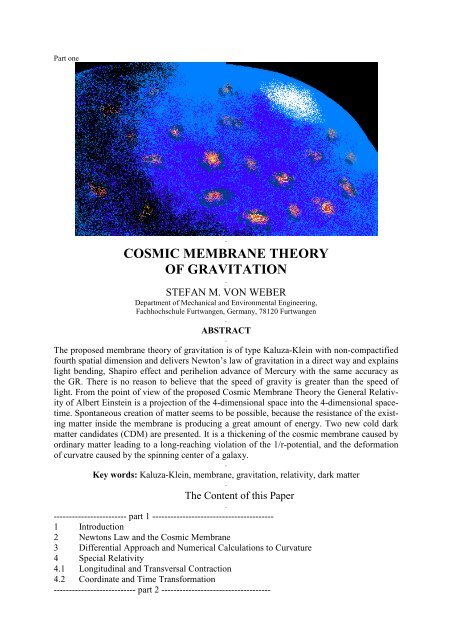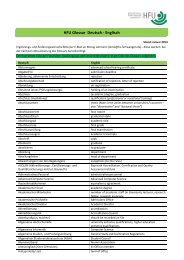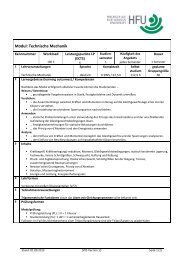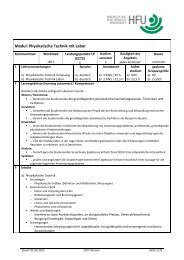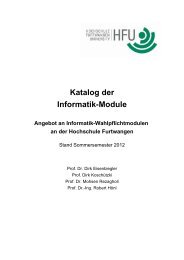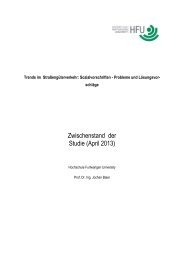COSMIC MEMBRANE THEORY OF GRAVITATION
COSMIC MEMBRANE THEORY OF GRAVITATION
COSMIC MEMBRANE THEORY OF GRAVITATION
You also want an ePaper? Increase the reach of your titles
YUMPU automatically turns print PDFs into web optimized ePapers that Google loves.
Part one<br />
⋅<br />
<strong>COSMIC</strong> <strong>MEMBRANE</strong> <strong>THEORY</strong><br />
<strong>OF</strong> <strong>GRAVITATION</strong><br />
⋅<br />
STEFAN M. VON WEBER<br />
Department of Mechanical and Environmental Engineering,<br />
Fachhochschule Furtwangen, Germany, 78120 Furtwangen<br />
⋅<br />
ABSTRACT<br />
⋅<br />
The proposed membrane theory of gravitation is of type Kaluza-Klein with non-compactified<br />
fourth spatial dimension and delivers Newton’s law of gravitation in a direct way and explains<br />
light bending, Shapiro effect and perihelion advance of Mercury with the same accuracy as<br />
the GR. There is no reason to believe that the speed of gravity is greater than the speed of<br />
light. From the point of view of the proposed Cosmic Membrane Theory the General Relativity<br />
of Albert Einstein is a projection of the 4-dimensional space into the 4-dimensional spacetime.<br />
Spontaneous creation of matter seems to be possible, because the resistance of the existing<br />
matter inside the membrane is producing a great amount of energy. Two new cold dark<br />
matter candidates (CDM) are presented. It is a thickening of the cosmic membrane caused by<br />
ordinary matter leading to a long-reaching violation of the 1/r-potential, and the deformation<br />
of curvatre caused by the spinning center of a galaxy.<br />
⋅<br />
Key words: Kaluza-Klein, membrane, gravitation, relativity, dark matter<br />
⋅<br />
The Content of this Paper<br />
⋅<br />
------------------------ part 1 ----------------------------------------<br />
1 Introduction<br />
2 Newtons Law and the Cosmic Membrane<br />
3 Differential Approach and Numerical Calculations to Curvature<br />
4 Special Relativity<br />
4.1 Longitudinal and Transversal Contraction<br />
4.2 Coordinate and Time Transformation<br />
--------------------------- part 2 ------------------------------------
4.3 Momentum, Mass and Energy<br />
4.4 Membrane Theory and Basic Physical Phenomenons<br />
4.5 Experiments Concerning Special Relativity<br />
4.6 Apparent Constancy of Velocity of Light<br />
4.7 Tidal and frequency effects<br />
5 Classical Proofs of General Relativity<br />
5.1 Shapiro Effekt, Light Bending and Depth of Space<br />
5.2 Perihelion Advance of Mercury<br />
--------------------------- part 3 ------------------------------------<br />
6 Novel Proofs of General Relativity<br />
6.1 Electron and Space Torsion<br />
6.2 Gravitational Waves<br />
6.3 Anomaly of Pioneer 10 and 11 data<br />
7 Cosmology<br />
7.1 The Cosmological Constant and the Expansion of the Universe<br />
7.2 Dark Matter caused by the etherwind<br />
7.3 Quintessence or Dark Matter and the Expansion of the Universe<br />
7.4 Dark Matter and Frame Dragging, Geodetic Precession<br />
8 Analysis and Conclusions<br />
References<br />
.<br />
Link back to the index:<br />
home: http://www.fh-furtwangen.de/~webers/index.htm<br />
⋅<br />
Last revision of this paper: 11/2006<br />
⋅<br />
1 Indroduction<br />
⋅<br />
(First version 03/1997, last update 05/2004) In 1919 two expeditions were undertaken to Sobral and<br />
Principe to observe the solar eclipse with the aim to proove the General Relativity of Albert<br />
Einstein (1916). One of the initiators was A.S.Eddington. The vertical axis in Fig. 1 shows at<br />
that time observed angles (in arcseconds) of light bending for sun-near trajectories (Mattig<br />
1999). The smooth line is the forecast of the General Relativity. The horizontal axis shows the<br />
nearest distances y of the trajectories to the centre of the Sun (scaled in radii of the Sun).<br />
⋅<br />
1.5<br />
1.0<br />
0.5<br />
α [arcsec]<br />
0<br />
1.5 2 3 4 5<br />
Fig. 1. - Light bending data 1919.<br />
The line is the forecast of General Relativity,<br />
y is the distance of trajectory in radii of Sun<br />
⋅<br />
Later it was said Eddington had only measured what he had wished to see, and moreover, the<br />
error of measurement had been greater than the effect he seeked. Other measurements (in<br />
Takegon 1929, in Timbuktu 1959) confirmed Eddington, but showed also that an additional<br />
y
amount of light bending is possible and likely in the special case of sun-near trajectories,<br />
above the amount General Relativity predicts.<br />
The reason sun-near light bending measurements are no longer carried out is the use of satellites<br />
and radio signals of quasars. These measurements confirm the theoretical value φ=4a/y<br />
of General Relativity with such an accuracy that sun-near measurements are thought to be<br />
unnecessary. (2a is the Schwarzschild radius of the Sun, y the perpendicular distance of the<br />
light trajectory from the centre of the Sun.) What a pity! The HIPPARCOS data only covers<br />
values upto 45° from the Sun, e.g. Robertson and Carter (1984) found sun-near deviations of<br />
the value φ= − 4a/y, too. They discussed the deviations, but took them as errors of measurement<br />
or as influences of the corona of the Sun. (To deletion of sun-near data see also Reasenberg,<br />
Shapiro et al. 1979 , to variance of bending data see Hamana, Martel & Futamase 2000).<br />
In 2002 Fomalont and Kopeikin measured the light deflection in the gravitational field of<br />
the Jupiter. But nearest distance was 14 times the Jovian radius (Fomalont & Kopeikin 2003),<br />
much to far to detect effects of order 1/y 4 . C.R. Keeton and A. O. Petters (2005, 2006) discuss<br />
the lensing of a quasar by the galactic black hole or other black holes to find the signatures of<br />
the fourth spatial dimension. In 2003 Bertotti et al. measured with very high precission the<br />
frequency shift in a radio signal transmitted by the Cassini spacecraft on its travel. The nearest<br />
distance to sun of the signal trajectory was about 1.6 sun radii. Unfortunately, for this conjunction<br />
point no frequency residuals are available. Membrane Theory expects for this point<br />
of the trajectory a negative deviation of about 3% from the General Relativity value according<br />
to the increase of the radial component of light speed. The effect decreases with 1/y 4 , where y<br />
is the nearest distance of the signal trajectory to the edge of sun.<br />
The author is seeing here just the starting point of a progress in the General Relativity theory.<br />
From point of view of the Cosmic Membrane Theory the General Relativity of Albert<br />
Einstein is a special projection of the 4-dimensional space into the 4-dimensional space-time.<br />
⋅<br />
In 1916 Albert Einstein had published his General Relativity with the idea of the curved<br />
space-time. The fourth dimension was born. In 1921 Kaluza (Kaluza 1921) extended the 4D<br />
space-time by the addition of a fourthh spatial dimension and made so the first attempt to<br />
unify electrodynamics and General Relativity, but the lack of physical evidence was criticized<br />
by scientists at that time. In 1926 Oskar Klein (Klein 1926) suggested that this extra dimension<br />
might be coiled into tiny, subatomic-scale tubes of Planck length. That was the startingpoint<br />
for leaving pure geometry and entering subatomic strings and branes and to try the unification<br />
of quantum theory with General Relativity. See e.g. Dirichlet-Branes by J. Polchinski<br />
(1995), string and M-theory and supermembrane by Seiberg & Witten 1996, Aldabe and Larsen<br />
1996, Keyl 1997, Duff 1998, Duff, Liu and Sati 2000, Greene 2000, Assis et al. 2000,<br />
Furtado, Bezerra & Moraes 2000, Duff, Liu & Sabra 2001, Khoury et al. 2001, Huey and<br />
Lidsey 2002. To control the use of a lot of additional dimensions six dimensions are curled<br />
into a Calabi-Yau manifold (c.f., e.g., Kachru, Laurence and Silverstein (1998). Siegel (2006)<br />
denies additional, not compactified spatial dimensions, because of a conflict with gravitational<br />
experiments.<br />
.<br />
The non-compactified additional fourth dimension we find, e.g., in von Weber 1998, Randall-Sundrum<br />
1999, Suntola 2003a. Non-compactified additional dimension Kaluza-Klein<br />
theory combined with quantum theory we find in Wesson et al. 1996, Pavsic 1997, Randall-<br />
Sundrum 1999, Darabi, Sajko & Wesson 2000, Dvali, Gabadadze and Porrati (2000), Deffayet,<br />
Landau, Raux, Zaldarriaga and Astier (2002), Louko and Wiltshire 2002, O'Callaghan,<br />
Echaurren and Mills (2003). Spatial whirlpools in General Relativity were investigated by<br />
Cartan in the 1920-th and then by Hehl et al. (Hehl 1973, Hehl, Heyde, Kerlick and Nester<br />
1976, Hehl and Obukhov 2001). Another strong impetus came from the cosmology (cf. e.g.
Turok & Hawking 1998, Turner & Tyson 1999). The big bang, inflation theory and cold dark<br />
matter are essential mile-stones.<br />
⋅<br />
The idea that vacuum is more than empty space goes back to Faraday and Maxwell, to Dirac,<br />
Casimir and de Sitter (cf. Haisch & Rueda 2001), Brans and Dicke 1961. Ponce de Leon 1988<br />
and Billyard & Wesson 1994 connect GR, the fifth dimension and the de Sitter vacuum. (Cf.<br />
also Haisch, Rueda & Dobyns 2001.) A class of Kaluza-Klein solutions curved in 4D and flat<br />
in 5D, but without oscillatory term, gave Liu & Wesson 1998, Liu & Mashhoon 2000. A 4D<br />
theory using higher terms of the GR field equations is given by Lewis, Doran & Lasenby<br />
2000. That idea will be essential for the proof of the Cosmic Membrane Theory. W.G. Tifft<br />
(1997) and I. Schmelzer (2000) remark that the cosmic frame appears to be fundamental.<br />
⋅<br />
The "membrane viewpoint" goes back to the Znajek-Damour bubble-formalism and to the<br />
"membrane paradigm" of Price and Thorne (Price & Thorne 1986). To quote them: "The<br />
membrane viewpoint has the goal of providing astrophysicists with mental pictures physical<br />
intuition, computational techniques, and other research tools." The notion domain wall is<br />
sometimes used instead membrane (c.f., e.g., Huey and Lidsey 2002, Gass and Mukherjee<br />
1999). To quote Deffayet et. al. (2000); " The brane-induced gravity models are a particular<br />
class of brane-world models, which can be defined as models where our four dimensional<br />
(4D) universe is considered to be a surface (called 'brane') embedded into a higher dimensional<br />
bulk space-time. Brane-world models are inspired by superstring-M theory, and can be<br />
regarded as some low energy effective models of more fundamental underlying theories, but<br />
have also interest on their own in providing new phenomenological ideas. We will only consider<br />
here the case where the bulk is five dimensional (5D)".<br />
⋅<br />
the<br />
4-dimensional<br />
space Σ<br />
expansion<br />
cosmic<br />
membrane<br />
visible<br />
part of<br />
cosmos<br />
expansion<br />
our<br />
galaxy<br />
Fig. 1.1 - Model of expanding cosmos<br />
⋅<br />
The 4-dimensional relativistic Cosmic Membrane Theory is based on the imagination of<br />
an ether-filled 4-dimensional hyperspace Σ (or bulk space, as sometimes called). In this<br />
hyperspace a 3-dimensional cosmic membrane (brane, supermembrane, quantum vacuum,<br />
expanding shell) expands with high speed VE in the same manner as a balloon is blown up<br />
(Fig. 1.1). This membrane is our cosmos. (Do not take the Cosmic Membrane for a Domain<br />
Wall as described in Gass and Mukherjee, 1999, but think a stuff with density, pressure or<br />
tension and perhaps some velocity (Schmelzer 2000)). The author thinks the membrane consisting<br />
of tiny torus-shaped curls (korns, grains) with diameters of Planck length. In M-Theory<br />
we find similar constructions, e.g. the curled Calabi-Yau spaces (cf. Kachru et al. 1998,<br />
Greene 2000), but in this theories the existence of additional dimensions is taken as physical<br />
reality. Similiarly to cosmic membrane theory the scalar field Φ in some quintessence theories<br />
is a function of speed VE (e.g. Carroll 1998 or Albrecht et al. 2001). But in the cosmic membrane<br />
theory the properties of the membrane depend merely on the tension, i.e., they depend
only in an indirect way on the speed VE of expansion. Jimerson (1991) gave a similar model,<br />
but without the ether flux.<br />
⋅<br />
The membrane is of tiny thickness in the fourth dimension and has a strong tension (c.f.<br />
Aldabe and Larsen 1996, Battye et al. 2005), but the fourth spatial dimension of Σ is of the<br />
same kind as our common three spatial dimensions x, y, z. Only the scale factor is unknown.<br />
This model avoids the difficulties with Maxwell’s equations (cf. Burgbacher, Lämmerzahl<br />
and Macias 1999). The size of the curls hasn't changed from the Big Bang up to now (Kolb et.<br />
al. 1986) or has changed (Schmelzer 2000). Here the author has no opinion. A five dimensional<br />
space-time one may get also from the heterotic M-theory (cf. Witten 1996, Horava and<br />
Witten 1996, Randall-Sundrum 1999, Dvali, Gabadadze and Porrat (2000), Louko and Wiltshire<br />
2002, Deffayet et al. (2002)). In the GR, time was established instead of the fourth spatial<br />
dimension, but hitherto, the author avoids its use as fifth dimension in the first instance.<br />
(Greene (2000) says that the number of time dimensions is open.).<br />
⋅<br />
The motor of the expansion of our cosmos is the momentum of the mass of the membrane<br />
(In this point there is a difference between Schmelzer's General Ether Theory and Membrane<br />
Theory (Schmelzer 2000)). Spontaneous creation of matter seems to be possible, because the<br />
resistance of the existing matter inside the membrane is producing a great amount of energy<br />
(cf. Vuletic 1997). But this is not the return to the Steady State Universe of Hoyle, Bondi and<br />
Gold (1948).<br />
⋅<br />
The Cosmic Membrane Theory is not a quantum theory. But this fact does not mean that the<br />
author denies the existence of a thing called graviton. The change of the position of a massive<br />
body relatively to the membrane changes the curvature of the membrane. This change propagates<br />
from korn to korn of the membrane, so as an acoustic sound wave propagates from<br />
molecule to molecule of a gas. This mechanism of propagation one can surely describe by the<br />
action of a graviton. But that what gravity means usually - the force between two massive<br />
bodies with a great distance between them - is connected with the graviton indirectly only. In<br />
this case the pure curvature of space, i.e. the slope of the membrane, together with the force of<br />
the ether wind is the cause of gravity. In this sense the graviton is only good for the microworld<br />
(cf. Kogan 2001). The decission whether the graviton is massless or massive is in this<br />
context not important, since a mass has no influence on the large scale gravity (Kogan 2001).<br />
⋅<br />
The pro and cons to the vacuum (field, fabric, zero-point energy, superfluid or membrane)<br />
and to the (a)ether fill libraries. To quote here Einstein (1920, 1950), Ponce de Leon 1988,<br />
Billyard & Wesson 1994, Weber 1995, Schmelzer 2000, Haisch & Rueda 2001, Haisch,<br />
Rueda & Dobyns 2001, and to a serious aether discussion Prokhovnik 1993, and the author<br />
remarks that membrane stuff and aether are two different things. From point of view of Cosmic<br />
Membrane Theory the General Relativity is in all static cases a projection of the 4dimensional<br />
space into the 4-dimensional space-time.<br />
⋅<br />
The Brans-Dicke relativistic theory of gravitation (Brans and Dicke 1961) is founded on<br />
Mach's principle that the phenomenon of inertia ought to arise from accelerations with respect<br />
to the general mass distribution of the universe. To avoid long-range interactions, Brans and<br />
Dicke suggest a scalar field φ (cosmic field). Its field strength has the dimension of G −1 =c 2 /γ,<br />
i.e. [Kg/m]. Field strength φ is proportional to gravitational potential of the total mass MU of<br />
the universe. We think a gas sphere with average density ρ=10 −26 [Kg/m3]. The radius of the<br />
Universe used by Brans and Dicke was about R=10 26 [m]. The potential at the centre of the<br />
2<br />
sphere is φ ≈ ρR<br />
≈ 10 26 −1<br />
[Kg/m]. Because this value is not far from G ≈ 10 27 [Kg/m], Brans<br />
and Dicke stated φ=G −1 . The field equations for gravitation are now obtained by replacing G
with φ −1 in Einstein's field equations and adding an additional energy-momentum tensor Tφ μν<br />
for the φ-field in the source of the gravitational field. The theory of Brans and Dicke is interesting<br />
in that sense, that it is giving a deeper insight into the workshop of gravitation compared<br />
with the GR of Einstein, and it is not far from membrane theory. From point of view of<br />
the membrane theory now three remarks:<br />
• Field φ has here properties of the membrane tension Fo, especially its propotionality to<br />
G −1 ,<br />
• but the radius of the universe may be much larger than 10 26 [Kg/m] (c.f. ch. 7.1), and<br />
• the Universe is closed, i.e. there does not exist any border and therefore no distance R<br />
⋅<br />
The class of Dvali-Gabadadze-Porrati brane worlds of 3D branes in 5D bulk space-time yields<br />
Newton's law of gravity too, but only in the near surrounding of a mass. For great distances r<br />
a potential arises which is descending with 1/r 2 .The supposition that gravity propagates<br />
through the bulk space complicates the theory. The bulk metric (see Deffayet et al. 2002) can<br />
only be an Euclidean metric. Correct is the idea of some "coupling between bulk space-time<br />
and brane localized matter fields when the conformal invariance of the brane theory is broken".<br />
The author calls this phenomenon etherwind.<br />
⋅<br />
It is interesting, that the biologist C. Calvet (2000) finds a similar field (Background Field)<br />
by the means of pure logic. The features are similar to those of the cosmic membrane, i.e. it<br />
may form a sphere in a hyperspace, and it has tension by the action of strings, and last but not<br />
least, torsion yields electromagnetic fields. Interesting also the idea that at the centre of the<br />
Universum could exist a Primeordial Star as a remainder of the Big Bang explosion. But from<br />
view of Cosmic Membrane Theory we would have no chance to observe it.<br />
⋅<br />
The important questions of special relativity will be discussed in an own chapter. The Lorentz<br />
transformation or a similar transformation with length and cross contraction (Weber<br />
1995) are candidates. With both transformations one can declare the change of mass and time<br />
and the whole set of experiments, e.g. Thomas precession, the experiments of Michelson-<br />
Morley, Fizeau and Trouton-Noble. The experiment of Haefele and Keating needs additionally<br />
Einstein’s Principle of Equivalence. The conservation laws of energy and momentum and<br />
Maxwell’s equations are valid. Gravitational waves are imaginable as transversal waves as<br />
well as longitudinal waves. The existence follows from 3D analogy using the common wave<br />
equation. (Weinberg 1972, Fliessbach 1990, White et al. 1993). In the Cosmic Membrane<br />
Theory the frame dragging (Thirring-Lense effect) is logically connected with the electrostatic<br />
field of the electron. Starting from the depth of space at the edge of Sun there exists a logical<br />
chain of calculations ending with the Compton wave-length of the electron. It will be fitted<br />
with an accuracy of 0.8%.<br />
⋅<br />
Chapter 2 contains a geometrical derivation of the curvature of the membrane for the special<br />
case of radial symmetry, chapter 3 a differential approach. In chapter 4 it will be shown that<br />
the existence of a space filling stuff (vacuum, superfluid or cosmic membrane) does not contradict<br />
Special Relativity. Besides the Lorentz transformation the author describes another<br />
possible transformation with length and cross contraction, and well known experiments and<br />
their relevance to the membrane theory will be discussed in brief. Chapter 5 deals with the<br />
classical proofs of the General Relativity as Shapiro effect (travel time retardation), light<br />
bending and the perihelion advance of mercury. The perihelion advance of mercury is used to<br />
discuss some basic questions. Here we find the important new constant moc 2 . Space drilling<br />
and gravitational waves are novel proofs. Chapter 6 deals with them. Chapter 7 presents a new<br />
cold dark matter candidate (CDM) and thoughts concerning some other cosmological questions.
⋅<br />
2 Newton’s Law and the Cosmic Membrane (First version 11/1995, last update 04/2005)<br />
⋅<br />
In the past there were made several attempts to explain Newton's law of gravitation. The<br />
General Relativity does not derivate this law from basic principles, but uses it as limiting law<br />
to find solutions of the field equations. All attempts to use quantum theory (cf. e.g. Th. B.<br />
Andrews (2001)) had to define an unlimited speed of the wave functions, because of the<br />
measurements of Tom Van Flandern (1998) concerning the direction of gravity between earth<br />
and sun.<br />
But Newton’s law we can derive from the membrane hypothesis directly (Weber 1998). The<br />
expanding cosmic membrane is exposed to the ether wind (Fig. 2.1). If the membrane and the<br />
ether wind are exactly perpendicular then each korn and so the membrane in all shall experience<br />
no or insignificant resistance. But matter in the membrane resists and causes a deformation<br />
of the membrane. The resistance of the membrane is caused by the tensile force Fo (connected<br />
over c 2 with the density ρ of the membrane. In Turok & Hawking (1988) Fo appears as<br />
four form field. Interesting here is also the theory of Patricio Valdés Marin (2003). The author<br />
cites him:" I suggest consequently that the cause of universal gravitation is the expansion of<br />
the universe." O'Callaghan, Echaurren and Mills (2003) have similar ideas. I quote them:<br />
"The energy associated with these energy vortexes that is directed perpendicular to the surface<br />
of three-dimensional space to become depressed with respect to the fourth spatial dimension".<br />
⋅<br />
The hyperspace (or bulk space, as sometimes called) Σ with its four spatial orthogonal dimensions<br />
X, Y, Z, and W is supposed to be flat (Liu & Wesson 1998, Darabi, Sajko & Wesson<br />
2000, Schmelzer 2000, Huey and Lidsey 2002, M. Grady 2002). So we have to deal with<br />
a simple Euclidean metric g μν . A rest frame moving with the membrane shall have the orthogonal<br />
axes x, y, z and w. The scale factors are unknown. They depend on the unknown<br />
velocity VE of expansion. W is transformed to w by a Lorentz-like formula w=(W-VE t)κ.<br />
Factor κ contains the unknown scale and time transformation. In this rest frame the Euclidean<br />
metric is simply<br />
ds ² = dx²<br />
+ dy²<br />
+ dz²<br />
+ dw²<br />
.<br />
But x, y, z are not coordinates inside the membrane. The simplicity of the 4D metric hides<br />
the complexity of 3D forms, since there is no term containing the time as in the GR or in all<br />
other Kaluza-Klein theories (cf. e.g. Ponce<br />
⋅<br />
σ<br />
-VE<br />
⋅<br />
Fig.2.1 - Deformation of memebrane by ether wind at place of matter<br />
⋅<br />
de Leon 1988). Furthermore, to get a solution in our common coordinates, we had to perform<br />
some transformations. In the membrane theory the velocity of light is a local property of the<br />
membrane (Ellis et al. 2000). Time is a property of physical processes (Hawking 1988) and<br />
depends on the local position at the membrane and on the motion relative to the membrane.<br />
M<br />
Σ
The absence of time in the metric means that the membrane theory in this special form can<br />
deal with a static geometry only. The use of the orthogonal "world coordinates" x, y, z, w we<br />
can compare with the introduction of a hypersurface-orthogonal fiducial observer (FIDO) by<br />
Price and Thorne 1986.<br />
The author sees the fourth spatial coordinate not as a trick to simlify mathematics (c.f. Durham<br />
2000). It is reality, and we can measure the curvature of our 3D subspace.<br />
⋅<br />
In the case of a single central load the cosmic memrane (the 3D subspace) deformes with radial<br />
symmetry. The ordinary differential equation (ODE) of the deviation w(r) from its zero<br />
position we can deduce geometrically from the analogous case of a 2-dimensional membrane<br />
in the 3-dimensional space x,y,z. (Weber 1998, compare also Brill 2000). The membrane shall<br />
be ideal, i.e. it stretches linearly to any tension. Fig. 2.1 and 2.3 show the gravitational funnel<br />
surrounding a mass M. The funnel is of spherical symmetry if the mass is a sphere and other<br />
masses are fare away. That means, we can restrict us to the coordinates r and z. Our first aim<br />
is to find the equation of curvature z"(r). Our way is purely gemetrical here. The starting point<br />
is the equilibrium of forces for a small piece of the membrane with the form of a saddle as<br />
shown in fig. 2.2. If the tension Fo of the membrane is much greater as the additional tension<br />
caused by the load, then the two pairs of forces Fr-Fr and Fz-Fz have got nearly identical<br />
amounts. (Strictly speaking neither Fr is showing exactly in r-direction, but is laying in the<br />
membrane, nor Fz is showing exactly in the z-direction.) As a consequence the angle between<br />
the two forces Fr must be identically with the angle between the two forces Fz, since the resultants<br />
must cancel one another. From this follows the equality of the curvatures 1/R1 and<br />
1/R2 and from this R1=R2.<br />
⋅<br />
Fr<br />
Fz<br />
R2<br />
R1<br />
Fz<br />
Membran<br />
Fig. 2.2: Forces on a piece of membrane<br />
⋅<br />
The radius of curvature R1 of the membrane in r-direction (fig. 2.3) we get from the deviation<br />
z(r) an its derivatives (Stoecker 1993).<br />
3/<br />
2<br />
R = (( 1+<br />
z′<br />
²) ) / z′<br />
′<br />
Fr<br />
1 (2.1)<br />
R2 is the radius perpendicular to R1. We calculate R2 using the imagination of a pipe with its<br />
axis in radial direction and a declination according to the declination in r-direction of the<br />
membrane at point P. The pipe touches the membrane in a small area surrounding point P (fig.<br />
2.4).<br />
⋅
P<br />
R1<br />
x,r<br />
Fig. 2.3 - Radius of curvature of the membrane in r-direction at point P<br />
⋅<br />
R2<br />
P r<br />
Fig. 2.4 - Radius of curvature R2 of the membrane perpendicular to R1<br />
⋅<br />
R2 we get from the vertex radius RE of curvature of the horizontal ellipse of intersection (fig.<br />
2.5). However, the radius RE is identical with the radius r(P). r(P) is the radius of the circle<br />
surrounding the z-axis. With the small half-axis B=R2 and the great half-axis<br />
A=R2/sin(arctan(z’)),<br />
A = ( R2<br />
1+<br />
z′<br />
² ) / z , B = R2<br />
, (2.2)<br />
the equation of the ellipse of intersection in the x-y-plane solved for x is<br />
x = A 1− y²<br />
/ B²<br />
(2.3)<br />
With<br />
x′<br />
= −<br />
B²<br />
Ay<br />
(2.4)<br />
1−<br />
y²<br />
/ B²<br />
and<br />
and<br />
Ay²<br />
A<br />
x′<br />
′ = −<br />
−<br />
(2.5)<br />
4 3<br />
B ( 1−<br />
y²<br />
/ B²)<br />
B²<br />
1−<br />
y²<br />
/ B²<br />
R E<br />
=<br />
( 1+<br />
x′<br />
x ′′<br />
2 3<br />
)<br />
z<br />
y<br />
(2.6)<br />
and y=0 the vertex radius of curvature RE ( identical to r(P) ) is<br />
= B²<br />
/ A . (2.7)<br />
R E<br />
⋅
R2<br />
r<br />
P<br />
z<br />
ellipse of intersect.<br />
z’<br />
Fig. 2.5.: Horizontal ellipse of intersection with Vertex Radius of curvature r(p)=RE<br />
⋅<br />
Eq. 2.2 inserted in Eq. 2.7 gives<br />
R2<br />
z′<br />
RE = (2.8)<br />
2<br />
1 + z′<br />
According to the equilibrium of forces on curved surfaces we set<br />
R 1 = R2<br />
. (2.9)<br />
Since RE=r, Eq. 2.8 solved for R2(=R1) and inserted in Eq. 2.1 delivers the differential equation<br />
of the 2-dimensional membrane deviation z(r)<br />
2<br />
z′<br />
( 1 + z′<br />
)<br />
z ′′ = −<br />
(2.10)<br />
r<br />
To find the 3-dimensional cosmic membrane deviation w(r) we take in account the fact that<br />
the radius of curvature R1 will be compensated now by two perpendicular curvatures. Instead<br />
of Eq. 2.9 we set<br />
1 1 1<br />
= +<br />
(2.11)<br />
R1<br />
R2<br />
R2<br />
or R2=2 R1 . So we get the wished differential equation<br />
2w′<br />
( r)(<br />
1+<br />
w′<br />
²( r))<br />
w′′<br />
( r)<br />
= −<br />
(2.12)<br />
r<br />
Here w(r) is the depth of space in the fourth dimension. Positive w-direction is the direction<br />
of the expansion of the cosmos. In all cases of weak curvature we may neglect the small term<br />
w’ 2 and furthermore we may neglect the fine difference between r and the true arc length inside<br />
the membrane. So we get the simplified equation of curvature w“(r)=−2w‘(r)/r. Each<br />
function w(r)=Wo+C/r is a solution of the simplified equation 2.12 . The simlification of eq.<br />
2.12 together with setting equivalent radius r with the arc length makes the difference between<br />
our solution and an exact solution of the field equations. Differentiation of w(r)=Wo+C/r<br />
yields w‘(r)=−C/r². Fig. 2.6 shows that force Fg is Fg=Ksin(α), if α is the angle of slope.<br />
Considering only small angles it is sin(α)≈tan(α)=w‘. Replacing w‘ by –C/r², we get<br />
Fg=−KC/r². That is Newton's Law of Gravitation in the case if two masses. K is the ether<br />
force, C a free constant and Fg is the force of attraction.<br />
⋅<br />
membrane<br />
Fn<br />
α<br />
K<br />
K<br />
Fg<br />
α
Fig. 2.6: Parallelogram of forces<br />
⋅<br />
Since we often have to handle problems with spherical symmetry (e.g. in our solar system),<br />
we write the solution of the simplified equation 2.12 in the form of Eq 2.13a. R is the radius<br />
of the Sun, Wo the depth of space at the edge of the Sun. We define the mass-acceleration by<br />
the ether wind (force K for the unity of mass) just as Ae=gs/W’o, where gs is the gravitational<br />
acceleration at the edge of Sun, W’o the slope of the membrane at the edge of Sun, γ the<br />
gravitational constant.<br />
WoR<br />
w(<br />
r)<br />
= − , (2.13 a)<br />
r<br />
WoR<br />
w′<br />
( r)<br />
=<br />
(2.13 b)<br />
r²<br />
g s Mγ<br />
Ae<br />
= =<br />
(2.14)<br />
W ′ W R<br />
o<br />
o<br />
⋅<br />
The three classical proofs of the validity of a theory of gravitation are explanation of perihelion<br />
advance of Mercury, of light bending and of Shapiro effect of signal retardation by solar<br />
gravity. Novel proofs are the explanation of the Lense-Thirring effect (or frame dragging) and<br />
the explanation of the decrease of energy of pulsars orbiting each other based on the emission<br />
of gravitational radiation. Here the author refers to the chapters 5 and 6.<br />
⋅<br />
3 Differential Approach and Numerical Calculations to Curvature<br />
⋅<br />
(First version 03/1997, last update 08/2006) We can find the differential equation of the curvature of<br />
space in cases of radial symmetry in another way as shown in chapter 2. We take a small sector<br />
of space with a small angle α
Fr<br />
Ft<br />
Fg<br />
Fig. 3.2. - Forces acting on volume element ΔV<br />
⋅<br />
We neglect changes of the x-y-z-components of the tensile force Fo of the membrane and of<br />
the x-y-z-component of force Fec, which are all small compared with Fo. Therefore, for the<br />
derivation of the ODE of curvature, we use only the w-components of the forces acting on the<br />
volume element ΔV. The components are:<br />
2<br />
2<br />
= F α ( w′<br />
+ dw′<br />
)( r + dr)<br />
(3.1)<br />
Frw o<br />
Fcw 2 2<br />
= −Foα<br />
w′<br />
r<br />
(3.2)<br />
Fgw 2 2<br />
= −Ae<br />
ρ(<br />
r)<br />
α r dr<br />
(3.3)<br />
Neglecting small values the equilibrium of forces Frw+ Fcw + Fgw =0 gives the ODE Eq. 3.4<br />
for the depth of space w(r).<br />
2w′<br />
Ae<br />
ρ(<br />
r)<br />
w′′<br />
( r)<br />
= − + , (3.4)<br />
r Fo<br />
or with renamed coefficients<br />
2w′<br />
w′′ ( r)<br />
= − + Aρ(<br />
r)<br />
. (3.5)<br />
r<br />
The first term of the right-hand terms of the ODE 3.4 (or 3.5, respectively) yields Newton’s<br />
gravitational potential. The second term (with ether acceleration Ae) gives the influence of the<br />
ordinary matter distributed under central symmetry in the space.<br />
⋅<br />
A first estimation of the depth of space Wo we find, and thus the connection to the GR of A.<br />
Einstein (1916), if we treat as equivalent formally Feynman’s radius of excess<br />
rEx=a/3=491[m] to the geometrical path lengthening dSR from the edge of Sun to its centre.<br />
(Feynman et al.1987). The excess radius is calculated by Feynman for a sphere with constant<br />
density, but this fact does not harm us. One can show (numerically e.g.) that the geometrical<br />
path lengthening within and outside a sphere of constant density have got equal amounts. The<br />
depth of space and from this the geometrical path lengthening outside a sphere depends on the<br />
total mass of the sphere only, but not on the interior density distribution.<br />
To calculate the exterior geometrical path lengthening dSE we solve the integral eq. 3.6. The<br />
lengthening Δdr of a piece dr of membran is Δdr ≈ dr(1+ w' 2 (r)) 1/2 −dr ≈ dr w' 2 (r)/2. With eq.<br />
2.13b, i.e. w'(r)=WoR/r 2 , we find Δdr≈(Wo 2 R 2 /r 4 )dr/2.<br />
2 2<br />
2<br />
∞1<br />
∞<br />
2 Wo<br />
R Wo<br />
dS E = ∫ w′<br />
( r)<br />
dr = dr =<br />
R 2 ∫<br />
(3.6)<br />
R 4<br />
2 ⋅ r 6R<br />
With Feynman's value rEX=dSE=491 [m] and R=6.958×10 8 [m] we find a value of Wo=<br />
1.432×10 6 [m] or 1432 [km]. That is the depth of space at the edge of Sun. To find numerically<br />
the interior geometrical path lengthening dSI we calculate first the mean density of the Sun ρ=<br />
M/V= 1.991×10 30 [Kg]/((4π/3)(6.958×10 8 [m]) 3 )= 1.411 [Kg/m3]. With this value of ρ one<br />
can calculate an estimation of the membrane slope w’(r) solving the difference equation 3.7.<br />
2 2<br />
F w′<br />
o ( r + Δr)(<br />
r + Δr)<br />
− r ΔrρAe<br />
w′<br />
( r)<br />
=<br />
(3.7)<br />
2<br />
F r<br />
o<br />
Ft<br />
Fc
Eq. 3.7 follows from fig. 3.3. The force Fg =ρAEdV is caused by the ether acceleration AE<br />
acting on the volume element dV= r 2 dθdφdr with density ρ at point of balance P. Fg is balanced<br />
by the different directions of the membrane tension Fo inside and outside the shell of<br />
thickness dr. The tension Fo acts on the area of surface (r+dr) 2 dθdφ outside with slope<br />
w'(r+dr) and on the area of surface r 2 dθdφ inside with slope w'(r). Since w' is small, we can<br />
neglect all changes of the horizontal components of the membrane tension. Considering only<br />
the w-components we find eq. 3.8 and from it eq. 3.7.<br />
2<br />
2<br />
2<br />
F w′<br />
( r + dr)(<br />
r + dr)<br />
dφdϑ<br />
− F w′<br />
( r)<br />
r dϕdϑ<br />
= r dϕdϑdrρA<br />
(3.8)<br />
o<br />
Fo<br />
w'(r+dr)<br />
P<br />
Fg<br />
o<br />
dr<br />
⋅<br />
r<br />
w'(r)<br />
Fig. 3.3: Forces at balance point P<br />
⋅<br />
One starts at r=R with a starting slope w'=Wo/R and goes step for step to r=0 finding there<br />
w’(0)=0. Fo=MAe /(4πWoR) [N/m 2 ] is the membrane tension, Ae is the ether accelaration<br />
(Eq. 2.14). The path-lengthening dSI is given by equation 3.9. Varying Wo and fitting so by<br />
iterative numerical integration the radius rEx=491 [m] to the value of dSI we get Wo =<br />
1.432×10 6 [m] once more.<br />
R 2<br />
w′<br />
( r)<br />
dS I = ∫ dr . (3.9)<br />
2<br />
0<br />
The constants Ae , Fo und the coefficient A we can now calculate from the depth of space Wo<br />
at the edge of Sun. The following numbers are calculated with the above found depth of<br />
space at the edge of Sun Wo=1.432×10 6 [m]. Ether acceleration is Ae=gs/W’o = gsR/Wo<br />
=1.361×10 5 [m/s 2 ] with gravitational acceleration gs=280.1[m/s 2 ] at the edge of Sun and radius<br />
of Sun R=6.958×10 8 [m]. Tension or tensile force of the membrane is Fo=Mgs/(4πWo 2 )=<br />
2.164×10 19 [N/m 2 ] with mass of Sun M=1.991×10 30 [kg]. ODE-coefficient A is A=Ae/Fo=<br />
6.289×10 -15 [m 2 /kg]. Of some interest may be the relation eq. 3.10 since the constant 4πγ is<br />
often used in the General Relativity. We find eq. 3.10 using the above relations for Fo and AE<br />
and with the relation gs =γM/r 2 .<br />
F<br />
A<br />
2 =<br />
o<br />
E<br />
1<br />
4πγ<br />
⋅<br />
Fo<br />
(3.10)<br />
The relation Fo=Mgs/(4πWo 2 ) for the membrane tension follows from fig. 3.4. The load L<br />
arises from the action of the ether wind on the total mass of Sun. We find L=MAE or L=<br />
MgsR/Wo . With w'=tan(α) ≈ sin(α)= L/F we find F=L/w' and with w'(R)=Wo/R we get F=<br />
MgsR 2 /Wo 2 . Since F is the total amount of tensive force acting on the surface of the Sun, we<br />
get the tension or force per unity of surface Fo by Fo= F/A= F/(4πR 2 )= (MgsR 2 /Wo 2 )/ (4πR 2 )<br />
or Fo=Mgs/(4πWo 2 ).<br />
E
F<br />
w(r)<br />
membrane<br />
α<br />
L<br />
w<br />
surface<br />
of Sun<br />
Fig. 3.4: Membrane tension<br />
⋅<br />
Th. Van Flandern (1998) supposes the propagation velocity of gravitation to be much higher<br />
than the speed of light. The reason is the fact that the Earth accelerates not towards the visible<br />
position of the Sun (a fact which is confirmed by exact astronomical observations), but to its<br />
real position. Inside the Cosmic Membrane Theory this contradiction is solvable. Both directions<br />
- acceleration and path of light - are on one line. The reason is the aberration that we do<br />
not see the Sun at its real place. The gravitation has no aberration. It must not propagate, since<br />
it is already there in the form of the gravitational funnel. Only small perturbations caused by<br />
the motion of the Sun around the centre of mass propagate with finite speed and meet the orbit<br />
with an incorrect angle. Therefore, we do not have any reason to suppose the propagation<br />
velocity of gravitation to be higher than the speed of light c.<br />
⋅<br />
The author performed in 1995-1996 some numerical calculations of the curvature of space to<br />
prove the correctness of the deduced formulas. The first calculation was the simple curvature<br />
of a 2-dimensional membrane under central load in the 3-dimensional space (rubber sheet).<br />
The curvature of an ideal 2-dimensional membrane is given by equ. 2.10. The author used a<br />
regular triangle with a grid of smaller regular triangles. Six regular triangles form a regular<br />
hexagon, but the author used only one and mirrored points near the boundaries. The solution<br />
of the difference equations was found iteratively. The deviations of the calculated curvature<br />
from the solution of equ. 2.10 are very small. Only at the central point and near the boundary<br />
greater deviations arose. The reason is that a hexagon is not a ideal circle (boundary effect)<br />
and that six connections of the central point to its neighbours do not model well a continuous<br />
membrane. The solution of the ODE equ. 2.10 the author calculated numerically by the Euler-<br />
Couchy method. The initial values have been fitted iteratively to find the minimum quadratic<br />
error.<br />
⋅<br />
The next proof was done by a spatial grid made from a regular tetrahedra. Twenty regular<br />
tetrahedra form a regular icosahedra. The similarity of an icosahedra with a sphere is not very<br />
good, but the advantage is that the grid models a dense package of spheres with 12 neighbours<br />
for each sphere. The load of the central point was directed in the fourth dimension. Fig. 3.5<br />
shows the used grid for one tetrahedra. The grid does not show any displacement in the visible<br />
three dimensions. But the calculated displacements in the w-dimension formed nearly exactly<br />
the demanded 1/r-curve. Near the central point and at the surface of the icosahedra the fit of<br />
both curves was not good, because of the boundary effects of the grid.<br />
⋅<br />
R
Fig. 3.5: Grid in the shape of a tetrahedra<br />
as part of a regular icosahedra<br />
⋅<br />
Fig. 3.6: Deviations between calculated curvature<br />
and 1/r-curve (Newtons potential)<br />
⋅<br />
Figure 3.6 shows the deviations of the grid results of curvature from the best fit of the 1/rpotential.<br />
In the range of 0.4 to 0.8 of r/rmax the fit is very good. Here is r the distance of the<br />
grid point from the centre. (see program Gravitat in http://www.fhfurtwangen.de/~webers/sourcode.htm<br />
). The program Gravitat the author has used also to calculate<br />
the small changes of the r-coordinates of points near the centre. This small displacements,<br />
which are decreasing with 1/r 4 , play some role in the calculation of sun-near light bending.<br />
There the tension of the membrane is increasing.<br />
⋅<br />
An improvement of the icosahedra result one will find by an enlarging of the number of<br />
points in the grid and a better spherical shape. So the author used another grid. Fig. 3.7 shows<br />
the grid points forming a sphere. The grid points are calculated as the centres of dense packed<br />
spheres (space-centered lattice of a dense package of spheres). It was the same kind of grid<br />
structure as used in the icosahedra case. The load acted only on the central point in the fourth
dimension (w-dimension). Each point of the grid has 12 neighbours (excepted boundary<br />
points).<br />
⋅<br />
Fig. 3.7: Spherical grid of a dense package of spheres.<br />
Each point marks the centre of a little sphere<br />
⋅<br />
Figure 3.8 shows in its upper part the calculated 1/r-potential (Newtons potential). The<br />
boundary effect at the central point is visible. Twelve connections are only an approximation<br />
of an ideal 3-dimensional membrane. The lower part of fig. 3.8 shows the errors, i.e., the deviations<br />
from the ideal 1/r-potential. In the range between 0.3 to 0.8 of r/rmax the error is very<br />
small. This grid the author also used later to calculate dark matter effects in galaxy models<br />
(see chapter 7.2) (see program Darksim3 in http://www.fh-furtwangen.de/~webers/sourcode.htm ).<br />
⋅<br />
Fig. 3.8 Calculated curvature from the spherical grid<br />
and deviations from the ideal 1/r-curve<br />
⋅<br />
Geometrical derivation, differential derivation and numerical calculations show convincing<br />
that a 3-dimensional membrane in 4 spatial dimensions delivers under central load exactly<br />
such a curvature as needed for Newton's potential. This is a strong argument for the assumption<br />
that our Universe is placed in or at such a membrane - the cosmic membrane.<br />
⋅<br />
4 Special Relativity<br />
⋅
The indroduction of a space filling resting stuff (here called membrane) leads necessarily to a<br />
special relativity, either based on the Lorentz transformation (c.f. Lorentz 1916) or on an<br />
equivalent transformation. In 1887 Michelson and Morley published the results of their experiments<br />
conducted to measure the relative motion of Earth and ether (cf. e.g. Michelson<br />
1881). The negative result is known and led to the special theory of relativity through the<br />
work of Voigt(1887), Lorentz (1892), Poincaré and Einstein (Einstein 1905) .<br />
⋅<br />
4.1 Longitudinal and Transversal Contraction (Fist version 05/1977, last update 08/2002)<br />
⋅<br />
The Lorentz transformation of space and time for the transition from one frame of reference<br />
to a frame of reference with another speed is known since Lorentz (Einstein 1905). The formulas<br />
are symmetrical. The transformation is in agreement with all experiments concerning<br />
the Special Relativity, and therefore it is the first choice. But following Hendrik Lorentz’<br />
traces (cf. Prokhovnik 1993) the author (and other authors, e.g. cf. Onoochin, 2004) has found<br />
still another transformation – so to speak the second choice. The chapters 4.1 to 4.3 deal with<br />
this transformation.<br />
⋅<br />
Fig. 4.1.1 shows two particles A and B in rest and moving. After the time t the moved body<br />
A with speed v in the rest frame σ is no longer the centre of a field of spherical symmetry<br />
(Fig. 4.1.2). The body B with parallel motion diminishes its distance x to the body A to keep<br />
its potential in the field of body A. Otherwise the distance A-B’ in the case of a moving pair<br />
would be greater than the distance A-B by reason of a finite speed of propagation of the fields<br />
of forces. A cross contraction could solve the problem. The planes of constant potential<br />
change from spheres in the case of rest to ellipsis in the case of motion. All axes of the ellipsis<br />
are shortened. That the longitudinal contraction is stronger than the perpendicular or cross<br />
contraction – this fact follows from the Michelson-Morley experiments (see below).<br />
B<br />
A<br />
Fig. 4.1.1. - Two particles in rest and moving with lines of constant potential<br />
ct<br />
Fig.4.1.2 Field surrounding a moved point A<br />
⋅<br />
The velocity of waves (forces, fields) in our 3-dimensional world σ (the membrane) is c.<br />
Now we consider photons in a cache consisting of two mirrors. That is nearly equivalent to<br />
one of the arms of the Michelson-Morley interferometer. If the cache is moving with a con-<br />
vt<br />
A<br />
A<br />
x<br />
B<br />
B’<br />
A’<br />
v
stant speed v (β=v/c) relatively to the membrane, we may define parallel and perpendicular<br />
orientations of the cache (see Fig. 4.1.3). The travel time of a photon there and back between<br />
the mirrors a and b does not change after a rotation of the cache, since the number of cycles<br />
remains unchanged.. Otherwise, we would observe in the interferometer a change of the interference<br />
pattern. We postulate a contraction of length with factor (1-β 2 ) 1/2 during a rotation<br />
from perpendicular to parallel orientation. Up to this point, the author agrees with H. Lorentz.<br />
The lenght contraction during rotation explains the zero result of the Michelson-Morley experiments.<br />
⋅<br />
b b’<br />
a a’’<br />
perpendicular<br />
v<br />
parallel<br />
a a’’ b b’ b’’<br />
Fig. 4.1.3. - Moving light cache perpendicular and parallel to v<br />
⋅<br />
But from the perpendicular case we said above that there might be a physically founded perpendicular<br />
or cross contraction. This cross contraction would get the contraction factor<br />
(1-β 2 ) 1/2 also. Together with the results of the Michelson-Moorley experiments this assumption<br />
then gives a length contraction of the value 1- β 2 .<br />
⋅<br />
For the most effects of time the real physical foundation is still outstanding. Therefore, we<br />
indroduce the speed-depending relativistic dilation of time as the experimental result of Ives<br />
and Stilwell e.g. (1938), or Otting respectively. In the case of the gravitational time effect, we<br />
follow Albert Einstein and his Principle of Equivalence (c.f. chapter 4.7) The time transformation<br />
for moving systems without (or with weak) gravitational fields uses the common time<br />
dilation according to Ives and Stilwell. This transformation is in agreement with the Lorentz<br />
transformation and is used in the following chapters.<br />
⋅<br />
4.2 Coordinate and Time Transformation (First version 06/1991, last update 08/2002)<br />
⋅<br />
The chapter contains the formulas following from the special relativity with both – cross and<br />
length contraction. First we consider the movement of a signal in a moved frame of reference<br />
σ‘.The speed v of σ‘ inside the rest frame σ may be directed in negative z-direction. Let x‘ be<br />
a fixed distance in σ‘. A light signal travels over the distance x‘, is reflected at the end and<br />
returns to the starting point. The true path a-b in the rest frame σ is shown in Fig. 4.2.1.<br />
⋅
Fig.4.2.1. Light path in σ, source and mirror resting in σ‘<br />
⋅<br />
Equations 4.2.1 follow from Fig. 4.2.1.<br />
x′<br />
a = , (4.2.1 a)<br />
sinα<br />
x′<br />
b = , (4.2.1 b)<br />
sinα<br />
sinα − β<br />
a<br />
b<br />
x‘<br />
2<br />
= 1 . (4.1.2 c)<br />
sinα does not depend on the scales of the reference system, because it is a dimensionless quotient.<br />
This is not valid for the coordinates of locus and time and their derivatives.<br />
⋅<br />
All longitudinal distances (with the same direction as speed v) in σ' are contracted by the factor<br />
1-β 2 , the transverse distances by (1- β 2 ) 1/2 . Assuming, that v and x are parallel and that the<br />
origins O and O' of the coordinate system σ and σ' coincided at time t=0, for a fixed x' in σ'<br />
has a length given by eq. 4.2.2 using σ-scales.<br />
x − vt<br />
x ′ =<br />
(4.2.2)<br />
2<br />
1− β<br />
An observer in σ' measures the distance x-vt with his contracted scale. He gets a value<br />
enlarged by the factor 1/β 2 .<br />
⋅<br />
For the construction of the time transformation we use the result of an experiment performed<br />
in 1938 by Ives and Stievell as well as Otting. They investigated the change of frequency of<br />
light emitted by canal rays in ray direction and in the opposite direction. They found that the<br />
mean value of the two frequencies follows<br />
⋅<br />
2 2<br />
+ 2<br />
( 1 v c )<br />
ν =ν<br />
(4.2.3)<br />
⋅<br />
Here v is the speed of the canal rays. v was measured by the simple Doppler effect of first<br />
order. ν is the frequency of the emitted line for v=0.We subtract from this result the amount<br />
of the common longitudinal Doppler effect of second order with moved source and resting<br />
observer and get<br />
2 2 ( 1− v 2c<br />
)<br />
⋅<br />
ν ′ = ν<br />
(4.2.4)<br />
⋅<br />
In agreement with the special theory of relativity we extrapolate eq. 4.2.4 in such a way, that<br />
the frequencies of periodical processes are diminished by the factor β in a moved system. Our<br />
time transformation for points resting in σ' is then<br />
⋅<br />
t ′ = tβ<br />
. (4.2.5)<br />
⋅<br />
α<br />
α<br />
v
We get the inverse coordinate transformation by resolving eq. 4.2.5 into x and replacing t by<br />
t‘/β in order to eq. 4.2.5.<br />
2<br />
x = x′<br />
β + vt′<br />
β<br />
⋅<br />
(4.2.6)<br />
⋅<br />
Since measurement of velocity in σ' uses a scale which is contracted by the factor β 2 and additional<br />
the clocks in σ' have a factor β lower speed, a velocity v in σ will give in σ' the amount<br />
v '= v/β 3 . Introducing this in eq.4.2.6 and with eq. 4.2.5 we get<br />
⋅<br />
( x − vt)<br />
x′<br />
=<br />
(4.2.7)<br />
2 2<br />
1− v c<br />
⋅<br />
The complete collection of transformation equations for coordinates and time of points resting<br />
in σ' is<br />
x − vt<br />
x′<br />
=<br />
(4.2.8 a)<br />
2 2<br />
1− v c<br />
2 2<br />
′ = t 1 v c<br />
(4.2.8 b)<br />
t −<br />
2 2<br />
( x′<br />
+ vt′<br />
)( 1 v c )<br />
x = −<br />
(4.2.8 c)<br />
t =<br />
t′<br />
2<br />
1− v<br />
(4.2.8 d)<br />
2<br />
c<br />
y<br />
y′<br />
=<br />
(4.2.8 e)<br />
2 2<br />
1− v c<br />
y ′ −<br />
2 2<br />
= y 1 v c<br />
(4.2.8)<br />
⋅<br />
Travels a point P' in σ' with velocity u' in the direction of the positive x-coordinate during<br />
time t', it crosses through the distance u't'. An observer in σ has to subtract from the coordinate<br />
x of P' in σ the amount vt (the motion of O' in σ in the time t) and the difference to multiply<br />
by the scale factor 1/β 2 to fit the above value, i.e.<br />
⋅<br />
u′ t′<br />
= x − vt β<br />
(4.2.9)<br />
( ) 2<br />
⋅<br />
The simple time transformation for the origin O' in σ' is t'= βt. But this transformation holds<br />
only in the singular reference system σ, since σ is the only system in which we may install<br />
"master clocks" by synchronizing them in the origin O and then moving them with "low"<br />
speed u to their fixed position x. Since the time dilatation diminishes in the case of small u by<br />
(1/2)(u 2 /c 2 ), but the time of transport increases only by 1/u, there remains a linear decrease of<br />
dilatation usable for the transport of the clocks without influencing the time flow.<br />
⋅<br />
In the moved system σ' this time invariant motion is not possible. Each motion of the clock<br />
from the origin O' in σ' to another point x' in σ' with a velocity v+u (in σ-scales) leads to an<br />
additional time dilatation<br />
⋅<br />
2<br />
⎛ v + u ⎞<br />
t ′ = t 1− ⎜ 2 ⎟ (4.2.10)<br />
⎝ c ⎠<br />
⋅<br />
related to a clock t in O of σ. For u
dt′<br />
=<br />
du<br />
t<br />
2 ( − v c )<br />
v<br />
1−<br />
For small u we get neglecting 2uv/c 2<br />
and with ut=x-vt<br />
Δt′<br />
=<br />
∫<br />
2<br />
dt′<br />
=<br />
c<br />
+ 2uv<br />
2<br />
c<br />
2 1<br />
− tv<br />
− v<br />
2<br />
( x − vt)<br />
2 2<br />
c<br />
⋅<br />
2<br />
⋅<br />
⋅<br />
u<br />
∫<br />
0<br />
dx<br />
(4.2.11)<br />
(4.2.12)<br />
v<br />
Δ t′<br />
= −<br />
(4.2.13)<br />
2<br />
c 1− v c<br />
⋅<br />
Denotes t(1-v 2 /c 2 ) 1/2 the time dilatation in O' of σ' then the time t' in the point x outside O' is<br />
⋅<br />
giving<br />
t<br />
( x − vt)<br />
2 2<br />
2 2<br />
′ = t 1−<br />
v c −<br />
(4.2.14)<br />
2<br />
c<br />
v<br />
1−<br />
v<br />
⋅<br />
t − vx<br />
t′<br />
=<br />
(4.2.15)<br />
2 2 2<br />
c 1− v c<br />
⋅<br />
a result, which is nearly identical to the Lorentz transformation of time. See also F. Selleri<br />
(2004). Going back to eq. 4.2.9 we get eq. 4.2.16.<br />
and with u=dx/dt and<br />
we get<br />
2 2<br />
( u′<br />
t′<br />
)( − v c ) vt<br />
x = 1 +<br />
(4.2.16)<br />
dt′<br />
=<br />
dt<br />
vu<br />
1−<br />
2<br />
c<br />
2<br />
1−<br />
v c<br />
2<br />
⋅<br />
⋅<br />
⋅<br />
c<br />
(4.2.17)<br />
2 2<br />
u′<br />
1−<br />
v c + v<br />
u = , (4.2.18 a)<br />
2 2<br />
u′<br />
v 1−<br />
v c<br />
1+<br />
2<br />
c<br />
u − v<br />
u′<br />
=<br />
(4.2.18 b)<br />
2 ⎛ uv ⎞<br />
1−<br />
β ⎜1−<br />
2 ⎟<br />
⎝ c ⎠<br />
⋅<br />
a result, which is similar to the addition theorem of velocities in the special theory of relativity.<br />
If one misses the Lorentz symmetry then compare Schmelzer's (2000) discussion to this<br />
topic..
End of part 1.<br />
Link back to the index:<br />
home: http://www.fh-furtwangen.de/~webers/index.htm<br />
⋅


